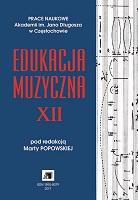Twórczość skrzypcowa Grzegorza Fitelberga
Grzegorz Fitelberg’s Violin Works
Author(s): Maryla RenatSubject(s): Music
Published by: Uniwersytet Jana Długosza w Częstochowie
Keywords: polish violin music; Grzegorz Fitelberg
Summary/Abstract: The article presents an unknown and previously not studied part of the work of the outstandingPolish conductor, Grzegorz Fitelberg (1879–1953), who during his youth was intensively engagedin composing and gained recognition not only at composition competitions. The study concernsseven violin works from his youthful period comprising:— Romance sans paroles in D major;— Romance sans paroles in A major op. 11;— Sonata No. 1 in A minor for violin and piano op. 2,— Berceuse in C sharp minor for violin and piano (without opus number);— Mazurka for violin and piano (in G major, without opus number);— Sonata No. 2 in F major for violin and piano op. 12;— unfinished Violin Concerto in D minor, op. 13.The musicological literature in Polish concerning Grzegorz Fitelberg focuses primarily on thepresentation of the conductor’s output, which overshadowed the composer's work that he quit in1918. It’s Fitelberg’s intense activity as a conductor probably that made him withdraw from composing,and the youthful works, which undoubtedly deserve attention, were forgotten.The analysis of Fitelberg’s violin works has shown that these works are worth rememberingdue to their artistic value. In these compositions, we can observe the evolution of the musicallanguage. The development of the melodics in the subsequent works was based on a gradual increaseof the interval mobility. In the piano part, in the harmonics, we can observe the developmentof chord structures, their expansion, enrichment with counterpoint voices, ‘foreign’ soundsand alterations. In line with harmonics evolution, we can observe the tendency to expand violinregisters. The stylistic profile of these works evolved from romantic patterns to more sophisticatedneo-romantic language and the first signs of impressionistic aesthetics. What has been highlightedin the sonatas is mainly the development of texture, whereas the lyrical miniatures evolve on thelevel of melodics and harmonics. In the Violin Concerto in D minor, the sound language is morecomplex, it serves dramatic purposes; it contrasts diatonicism with chromaticism, and the massifsound of the ensemble with that of the soloist action.Fitelberg’s violin compositions appear as artistically valuable and, at the same time, as the onesin which Fitelberg developed the foundations of his creative technique. Along with violin worksby other composers of the turn of the 19th and 20th century (Stojowski, Melcer, Maliszewski,Andrzejowski, Zarzycki), they constitute an important section of the chamber music compositionsof that period. Unfortunately, these compositions, even though they were recorded in 2010, arestill awaiting to gain more attention of performers and music lovers.
Journal: Edukacja Muzyczna
- Issue Year: 2017
- Issue No: 12
- Page Range: 53-82
- Page Count: 30
- Language: Polish

